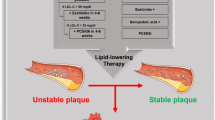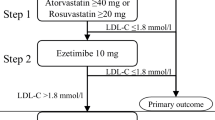Abstract
Purpose of Review
Recent advances in low-density lipoprotein cholesterol (LDL-C) lowering therapy have now enabled reducing LDL-C safely to very low levels. This review summarizes evidence from recent randomized clinical trials of intensive LDL-C lowering in patients with acute coronary syndrome (ACS) and provides a practical approach for LDL-C lowering to reduce the risk of recurrent ischemic events in this population.
Recent Findings
The risk of atherothrombotic events falls linearly with LDL-C level extending to very low achieved LDL-C levels (< 10 mg/dL) without apparent safety concerns. The addition of ezetimibe or proprotein convertase subtilisin/kexin type 9 (PCSK9) inhibitors (i.e., evolocumab or alirocumab) to statin therapy lowers LDL-C to very low levels (≤ 30–50 mg/dL) with safety under the conditions studied and reduces the risk of recurrent cardiovascular events in patients with atherosclerotic cardiovascular disease.
Summary
Current data support LDL-C lowering to levels below 70 mg/dL in patients post-ACS. Combination of high-intensity statins, ezetimibe, and if needed PCSK9 inhibitors merits consideration in such patients with ACS to optimize outcomes.


Similar content being viewed by others
Abbreviations
- LDL-C:
-
low-density lipoprotein cholesterol
- ACS:
-
acute coronary syndrome
- PCSK9:
-
proprotein convertase subtilisin/kexin type 9
- ASCVD:
-
atherosclerotic cardiovascular disease
- HR:
-
hazard ratio
- CI:
-
confidence interval
- ARR:
-
absolute risk reduction
- NNT:
-
number needed to treat
References
Papers of particular interest, published recently, have been highlighted as: • Of importance
Libby P, Everett B. Novel Antiatherosclerotic Therapies. Arterioscler Thromb Vasc Biol. 2019:ATVBAHA118310958.
Grundy SM, Stone NJ, Bailey AL, Beam C, Birtcher KK, Blumenthal RS, et al. 2018 AHA/ACC/AACVPR/AAPA/ABC/ACPM/ADA/AGS/APhA/ASPC/NLA/PCNA Guideline on the Management of Blood Cholesterol: Executive Summary: A Report of the American College of Cardiology/American Heart Association Task Force on Clinical Practice Guidelines. 2018 Nov 3. pii: S0735–1097(18)39033–8. https://doi.org/10.1016/j.jacc.2018.11.002
LaRosa JC, Grundy SM, Kastelein JJ, Kostis JB, Greten H. Treating to new targets steering C, et al. safety and efficacy of atorvastatin-induced very low-density lipoprotein cholesterol levels in patients with coronary heart disease (a post hoc analysis of the treating to new targets [TNT] study). Am J Cardiol. 2007;100(5):747–52.
Hsia J, MacFadyen JG, Monyak J, Ridker PM. Cardiovascular event reduction and adverse events among subjects attaining low-density lipoprotein cholesterol <50 mg/dl with rosuvastatin. The JUPITER trial (justification for the use of statins in prevention: an intervention trial evaluating Rosuvastatin). J Am Coll Cardiol. 2011;57(16):1666–75.
Wiviott SD, Cannon CP, Morrow DA, Ray KK, Pfeffer MA, Braunwald E, et al. Can low-density lipoprotein be too low? The safety and efficacy of achieving very low low-density lipoprotein with intensive statin therapy: a PROVE IT-TIMI 22 substudy. J Am Coll Cardiol. 2005;46(8):1411–6.
• Cannon CP, Blazing MA, Giugliano RP, McCagg A, White JA, Theroux P, et al. Ezetimibe added to statin therapy after acute coronary syndromes. The New England Journal of Medicine. 2015;372(25):2387–97 This trial showed reduction in cardiovascular events with the addition of ezetimibe to statin therapy.
• Sabatine MS, Giugliano RP, Keech AC, Honarpour N, Wiviott SD, Murphy SA, et al. Evolocumab and clinical outcomes in patients with cardiovascular disease. The New England Journal of Medicine. 2017;376(18):1713–22 This trial demonstrated reduction in cardiovascular events with evolocumab.
• Schwartz GG, Steg PG, Szarek M, Bhatt DL, Bittner VA, Diaz R, et al. Alirocumab and cardiovascular outcomes after acute coronary syndrome. The New England Journal of Medicine. 2018;379(22):2097–107 This trial showed reduction in cardiovascular events with alirocumab.
Randomised trial of cholesterol lowering in 4444 patients with coronary heart disease: the Scandinavian Simvastatin Survival Study (4S). Lancet. 1994;344(8934):1383–9.
Sacks FM, Pfeffer MA, Moye LA, Rouleau JL, Rutherford JD, Cole TG, et al. The effect of pravastatin on coronary events after myocardial infarction in patients with average cholesterol levels. Cholesterol and recurrent events trial investigators. N Engl J Med. 1996;335(14):1001–9.
Expert Panel on Detection E, Treatment of High Blood Cholesterol in A. Executive Summary of The Third Report of The National Cholesterol Education Program (NCEP) Expert Panel on Detection, Evaluation, And Treatment of High Blood Cholesterol In Adults (Adult Treatment Panel III). Jama. 2001;285(19):2486–97.
Cannon CP, Braunwald E, McCabe CH, Rader DJ, Rouleau JL, Belder R, et al. Intensive versus moderate lipid lowering with statins after acute coronary syndromes. N Engl J Med. 2004;350(15):1495–504.
Ridker PM, Cannon CP, Morrow D, Rifai N, Rose LM, McCabe CH, et al. C-reactive protein levels and outcomes after statin therapy. N Engl J Med. 2005;352(1):20–8.
Grundy SM, Cleeman JI, Merz CN, Brewer HB Jr, Clark LT, Hunninghake DB, et al. Implications of recent clinical trials for the National Cholesterol Education Program Adult Treatment Panel III guidelines. Circulation. 2004;110(2):227–39.
Perk J, De Backer G, Gohlke H, Graham I, Reiner Z, Verschuren M, et al. European guidelines on cardiovascular disease prevention in clinical practice (version 2012). The fifth joint task force of the European Society of Cardiology and Other Societies on cardiovascular disease prevention in clinical practice (constituted by representatives of nine societies and by invited experts). Eur Heart J. 2012;33(13):1635–701.
Schwartz GG, Olsson AG, Ezekowitz MD, Ganz P, Oliver MF, Waters D, et al. Effects of atorvastatin on early recurrent ischemic events in acute coronary syndromes: the MIRACL study: a randomized controlled trial. Jama. 2001;285(13):1711–8.
de Lemos JA, Blazing MA, Wiviott SD, Lewis EF, Fox KA, White HD, et al. Early intensive vs a delayed conservative simvastatin strategy in patients with acute coronary syndromes: phase Z of the a to Z trial. Jama. 2004;292(11):1307–16.
Giugliano RP, Wiviott SD, Blazing MA, De Ferrari GM, Park JG, Murphy SA, et al. Long-term safety and efficacy of achieving very low levels of low-density lipoprotein Cholesterol : a Prespecified analysis of the IMPROVE-IT trial. JAMA Cardiol. 2017;2(5):547–55.
Bohula EA, Giugliano RP, Cannon CP, Zhou J, Murphy SA, White JA, et al. Achievement of dual low-density lipoprotein cholesterol and high-sensitivity C-reactive protein targets more frequent with the addition of ezetimibe to simvastatin and associated with better outcomes in IMPROVE-IT. Circulation. 2015;132(13):1224–33.
Giugliano RP, Keech A, Murphy SA, Huber K, Tokgozoglu SL, Lewis BS, et al. Clinical efficacy and safety of Evolocumab in high-risk patients receiving a statin: secondary analysis of patients with low LDL Cholesterol levels and in those already receiving a maximal-potency statin in a randomized clinical trial. JAMA Cardiol. 2017;2(12):1385–91.
Giugliano RP, Pedersen TR, Park JG, De Ferrari GM, Gaciong ZA, Ceska R, et al. Clinical efficacy and safety of achieving very low LDL-cholesterol concentrations with the PCSK9 inhibitor evolocumab: a prespecified secondary analysis of the FOURIER trial. Lancet. 2017;390(10106):1962–71.
Cholesterol Treatment Trialists C, Baigent C, Blackwell L, Emberson J, Holland LE, Reith C, et al. Efficacy and safety of more intensive lowering of LDL cholesterol: a meta-analysis of data from 170,000 participants in 26 randomised trials. Lancet. 2010;376(9753):1670–81.
Silverman MG, Ference BA, Im K, Wiviott SD, Giugliano RP, Grundy SM, et al. Association between lowering LDL-C and cardiovascular risk reduction among different therapeutic interventions: a systematic review and meta-analysis. Jama. 2016;316(12):1289–97.
Sabatine MS, Wiviott SD, Im K, Murphy SA, Giugliano RP. Efficacy and safety of further lowering of low-density lipoprotein Cholesterol in patients starting with very low levels: a meta-analysis. JAMA Cardiol. 2018;3(9):823–8.
Qamar A, Bhatt DL. Effect of low Cholesterol on steroid hormones and vitamin E levels: just a theory or real concern? Circ Res. 2015;117(8):662–4.
Cohen JC, Boerwinkle E, Mosley TH Jr, Hobbs HH. Sequence variations in PCSK9, low LDL, and protection against coronary heart disease. N Engl J Med. 2006;354(12):1264–72.
Libby P. The forgotten majority: unfinished business in cardiovascular risk reduction. J Am Coll Cardiol. 2005;46(7):1225–8.
Ridker PM, Danielson E, Fonseca FA, Genest J, Gotto AM Jr, Kastelein JJ, et al. Rosuvastatin to prevent vascular events in men and women with elevated C-reactive protein. N Engl J Med. 2008;359(21):2195–207.
Preiss D, Seshasai SR, Welsh P, Murphy SA, Ho JE, Waters DD, et al. Risk of incident diabetes with intensive-dose compared with moderate-dose statin therapy: a meta-analysis. Jama. 2011;305(24):2556–64.
Ridker PM, Pradhan A, MacFadyen JG, Libby P, Glynn RJ. Cardiovascular benefits and diabetes risks of statin therapy in primary prevention: an analysis from the JUPITER trial. Lancet. 2012;380(9841):565–71.
Sabatine MS, Giugliano RP, Wiviott SD, Raal FJ, Blom DJ, Robinson J, et al. Efficacy and safety of evolocumab in reducing lipids and cardiovascular events. N Engl J Med. 2015;372(16):1500–9.
Giugliano RP, Mach F, Zavitz K, Kurtz C, Im K, Kanevsky E, et al. Cognitive function in a randomized trial of Evolocumab. N Engl J Med. 2017;377(7):633–43.
Bohula EA, Morrow DA, Giugliano RP, Blazing MA, He P, Park JG, et al. Atherothrombotic risk stratification and ezetimibe for secondary prevention. J Am Coll Cardiol. 2017;69(8):911–21.
Mega JL, Stitziel NO, Smith JG, Chasman DI, Caulfield M, Devlin JJ, et al. Genetic risk, coronary heart disease events, and the clinical benefit of statin therapy: an analysis of primary and secondary prevention trials. Lancet. 2015;385(9984):2264–71.
Colantonio LD, Rosenson RS, Deng L, Monda KL, Dai Y, Farkouh ME, et al. Adherence to statin therapy among US adults between 2007 and 2014. J Am Heart Assoc. 2019;8(1):e010376.
Rodriguez F, Maron DJ, Knowles JW, Virani SS, Lin S, Heidenreich PA. Association of Statin Adherence With Mortality in Patients With Atherosclerotic Cardiovascular Disease. JAMA cardiology. 2019.
Larsen LE, Stoekenbroek RM, Kastelein JJP, Holleboom AG. Moving targets: recent advances in lipid-lowering therapies. Arterioscler Thromb Vasc Biol. 2019;39(3):349–59.
Ray KK, Landmesser U, Leiter LA, Kallend D, Dufour R, Karakas M, et al. Inclisiran in patients at high cardiovascular risk with elevated LDL Cholesterol. N Engl J Med. 2017;376(15):1430–40.
Ray KK, Bays HE, Catapano AL, Lalwani ND, Bloedon LT, Sterling LR, et al. Safety and efficacy of Bempedoic acid to reduce LDL Cholesterol. N Engl J Med. 2019;380(11):1022–32.
Funding
Arman Qamar reports grants from NHLBI T32 postdoctoral training grant (T32HL007604) and grants from American Heart Association Strategically Focused Research Network in Vascular Disease grant (18SFRN3390085 and 18SFRN33960262).
Author information
Authors and Affiliations
Corresponding author
Ethics declarations
Conflict of Interest
Arman Qamar declares that he has no conflict of interest.
Peter Libby reports other from Kowa Pharmaceuticals, other from Amgen, other from AstraZeneca, other from Esperion Therapeutics, other from Ionis Pharmaceuticals, grants and other from Novartis, other from Pfizer, other from Sanofi-Regeneron, other from XBiotech, Inc., other from Corvidia Therapeutics, personal fees from DalCorPharmaceuticals, other from IFM Therapeutics, other from Olatec Therapeutics, other from Medimmune, and other from XBiotech, Inc.
Human and Animal Rights and Informed Consent
This article does not contain any studies with human or animal subjects performed by any of the authors.
Additional information
Publisher’s Note
Springer Nature remains neutral with regard to jurisdictional claims in published maps and institutional affiliations.
Publisher’s Note
Springer Nature remains neutral with regard to jurisdictional claims in published maps and institutional affiliations.
This article is part of the Topical Collection on Lipid Abnormalities and Cardiovascular Prevention
Rights and permissions
About this article
Cite this article
Qamar, A., Libby, P. Low-Density Lipoprotein Cholesterol After an Acute Coronary Syndrome: How Low to Go?. Curr Cardiol Rep 21, 77 (2019). https://doi.org/10.1007/s11886-019-1160-6
Published:
DOI: https://doi.org/10.1007/s11886-019-1160-6




